A Novel Air-Cooled Thermal Management Approach towards High-Power Lithium-Ion Capacitor Module for Electric Vehicles
Abstract
:1. Introduction
2. Numerical Solution
2.1. 3D Thermal Model
2.2. Governing Equations
2.2.1. Heat Generation Model for the LiC
2.2.2. Forced Air-Cooled Model
3. Experimental Test Bench
3.1. Test Bench Setup
3.2. Experimental Results
4. Validation Results
4.1. Forced Air-Cooled Simulation Results
4.2. Validation
5. Optimization of the ACTMS
5.1. Impact of the Inlet Air Velocity
5.2. Impact of Inlet and Outlet Positions
5.3. Impact of Gap Spacing between Neighboring Cells
5.4. Impact of Rotating the Position of the Module 90 Degrees (Side Cooling)
5.5. Impact of Uneven Gap Spacing between Neighboring Cells
5.6. Comparison of the Optimization Results
6. Conclusions
- Without a proper TMS and under natural convection, the temperature rise of the module is extremely high, and will result in thermal runaway.
- The 3D CFD model can predict the temperature values of the LiC module with a deficient error of calculation (less than 1%).
- With a constant gap between the cells, increasing the inlet air velocity of fans reduces the maximum temperature of the module and temperature uniformity. The first cells have a lower temperature rise compared to those in the middle. For the V = 4 m/s and 5 m/s, the maximum temperature of the module was reduced by 2.5% and 4.9% compared to the main case study with V = 3 m/s, respectively.
- Changing the inlet and outlet position led to different scenarios. The best scenario was using four fans from the left and right sides to blow the air into the module’s surface and designing the outlet on top of the cells. This reduced the maximum temperature and temperature uniformity by 26.5% and 37.3%, respectively.
- Rotating the module by 90° decreases the module’s maximum temperature and temperature uniformity by around 2% and 3% compared to the main case study, respectively.
- Increasing the gap spacing of the rotated module results in better temperature distribution, as the fans are blowing to the side surface of the LiCs with the same gap spacing. For the 1 mm, 2 mm, 3 mm, and 4 mm gap spacing for the rotated module, the maximum temperature decreased by 2%, 26.9%, 41.6%, and 44.6% compared to the main case study, respectively. For the mentioned gap spacings, the temperature difference compared to the main case reduced by 1%, 38.2%, 80.1%, and 86.7%, respectively.
- Uneven gap spacing can optimize the volume of the module, so by setting the d1 = 1 mm and d2 = 2 mm, the maximum temperature stays almost the same. However, the temperature difference was reduced by 53.2% compared to the main case study. After rotating the module and setting d1 = 1 mm and d2 = 2 mm, the maximum temperature and temperature uniformity decreased by 19.1% and 35.1% compared to the main case. By setting d1 = 2 mm and d2 = 3 mm, 5.5 °C temperature difference was achieved. In this case, the maximum temperature and temperature difference were reduced by 39.4% and 76.3% compared to the main study, respectively.
Author Contributions
Funding
Institutional Review Board Statement
Informed Consent Statement
Data Availability Statement
Acknowledgments
Conflicts of Interest
References
- Soltani, M.; Beheshti, S.H. A comprehensive review of lithium ion capacitor: Development, modelling, thermal management and applications. J. Energy Storage 2020, 34, 102019. [Google Scholar] [CrossRef]
- Jaguemont, J.; Karimi, D.; van Mierlo, J. Investigation of a Passive Thermal Management System for Lithium-Ion Capacitors. IEEE Trans. Veh. Technol. 2019, 68, 10518–10524. [Google Scholar] [CrossRef]
- Khaleghi, S.; Karimi, D.; Beheshti, S.H.; Hosen, S.; Behi, H.; Berecibar, M.; van Mierlo, J. Online health diagnosis of lithium-ion batteries based on nonlinear autoregressive neural network. Appl. Energy 2021, 282, 116159. [Google Scholar] [CrossRef]
- Omar, N.; Daowd, M.; Hegazy, O.; al Sakka, M.; Coosemans, T.; van den Bossche, P.; van Mierlo, J. Assessment of lithium-ion capacitor for using in battery electric vehicle and hybrid electric vehicle applications. Electrochim. Acta 2012, 86, 305–315. [Google Scholar] [CrossRef]
- Soltani, M.; Ronsmans, J.; Kakihara, S.; Jaguemont, J.; van den Bossche, P.; van Mierlo, J.; Omar, N. Hybrid battery/lithium-ion capacitor energy storage system for a pure electric bus for an urban transportation application. Appl. Sci. 2018, 8, 1176. [Google Scholar] [CrossRef] [Green Version]
- Berckmans, G.; Samba, A.; Omar, N.; Ronsmans, J.; Soltani, M.; Firouz, Y.; van den Bossche, P.; van Mierlo, J. Lithium ion capacitor—Optimization of thermal management from cell to module level. In Proceedings of the 2016 IEEE Vehicle Power and Propulsion Conference (VPPC), Hangzhou, China, 17–20 October 2016; pp. 1–6. [Google Scholar] [CrossRef]
- Karimi, D.; Behi, H.; Jaguemont, J.; Berecibar, M.; van Mierlo, J. A refrigerant-based thermal management system for a fast charging process for lithium-ion batteries. In Proceedings of the International Conference on Renewable Energy Systems and Environmental Engineering (IRESE), Global Publisher, Brussels, Belgium, 18 December 2020; pp. 1–6. [Google Scholar]
- Behi, H.; Karimi, D.; Jaguemont, J.; Gandoman, F.H.; Kalogiannis, T.; Berecibar, M.; van Mierlo, J. Novel thermal management methods to improve the performance of the Li-ion batteries in high discharge current applications. Energy 2021, 224, 120165. [Google Scholar] [CrossRef]
- Karimi, D.; Behi, H.; Akbarzadeh, M.; van Mierlo, J.; Berecibar, M. Holistic 1D Electro-Thermal Model Coupled to 3D Thermal Model for Hybrid Passive Cooling System Analysis in Electric Vehicles. Energies 2021, 14, 5924. [Google Scholar] [CrossRef]
- Karimi, D.; Behi, H.; Jaguemont, J.; Berecibar, M.; van Mierlo, J. Investigation of extruded heat sink assisted air cooling system for lithium-ion capacitor batteries. In Proceedings of the International Conference on Renewable Energy Systems and Environmental Engineering (IRESE), Brussels, Belgium, 18 October 2020; pp. 1–6. [Google Scholar]
- Behi, H.; Behi, M.; Karimi, D.; Jaguemont, J.; Ghanbarpour, M.; Behnia, M.; Berecibar, M.; van Mierlo, J. Heat pipe air-cooled thermal management system for lithium-ion batteries: High power applications. Appl. Therm. Eng. 2020, 183, 116240. [Google Scholar] [CrossRef]
- Karimi, D.; Hosen, M.S.; Behi, H.; Khaleghi, S.; Akbarzadeh, M.; van Mierlo, J.; Berecibar, M. A hybrid thermal management system for high power lithium-ion capacitors combining heat pipe with phase change materials. Heliyon 2021, 7, e07773. [Google Scholar] [CrossRef]
- Akbarzadeh, M.; Jaguemont, J.; Kalogiannis, T.; Karimi, D.; He, J.; Jin, L.; Xie, P.; van Mierlo, J.; Berecibar, M. A novel liquid cooling plate concept for thermal management of lithium-ion batteries in electric vehicles. Energy Convers. Manag. 2021, 231, 113862. [Google Scholar] [CrossRef]
- Möller, S.; Karimi, D.; Vanegas, O.; el Baghdadi, M.; Kospach, A.; Lis, A.; Hegazy, O.; Abart, C.; Offenbach, Â.B.Â. Application Considerations for Double Sided Cooled Modules in Automotive Environment. 2020. Available online: https://ieeexplore.ieee.org/document/9097721 (accessed on 16 November 2020).
- Karimi, D.; Jaguemont, J.; Behi, H.; Berecibar, M.; van den Bossche, P.; van Mierlo, J. Passive cooling based battery thermal management using phase change materials for electric vehicles. In Proceedings of the EVS33—33nd Electric Vehicle Symposium, Portland, OR, USA, 14–17 June 2020; pp. 1–12. [Google Scholar]
- Behi, M.; Mirmohammadi, S.A.; Ghanbarpour, M.; Behi, H.; Palm, B. Evaluation of a novel solar driven sorption cooling/heating system integrated with PCM storage compartment. Energy 2018, 164, 449–464. [Google Scholar] [CrossRef]
- Behi, H. Experimental and Numerical Study on Heat Pipe Assisted PCM Storage System. Master’s Thesis, School of Industrial Engineering and Management, Stockholm, Sweden, 2015. [Google Scholar]
- Behi, H.; Karimi, D.; Youssef, R.; Patil, M.S.; van Mierlo, J.; Berecibar, M. Comprehensive Passive Thermal Management Systems for Electric Vehicles. Energies 2021, 14, 3881. [Google Scholar] [CrossRef]
- Karimi, D.; Behi, H.; Jaguemont, J.; Sokkeh, M.A.; Kalogiannis, T.; Hosen, M.S.; Berecibar, M.; van Mierlo, J. Thermal performance enhancement of phase change material using aluminum-mesh grid foil for lithium-capacitor modules. J. Energy Storage 2020, 30, 101508. [Google Scholar] [CrossRef]
- Pu, L.; Zhang, S.; Xu, L.; Ma, Z.; Wang, X. Numerical study on the performance of shell-and-tube thermal energy storage using multiple PCMs and gradient copper foam. Renew. Energy 2021, 174, 573–589. [Google Scholar] [CrossRef]
- Behi, M.; Shakorian-poor, M.; Mirmohammadi, S.A.; Behi, H.; Rubio, J.I.; Nikkam, N.; Farzaneh-Gord, M.; Gan, Y.; Behnia, M. Experimental and numerical investigation on hydrothermal performance of nanofluids in micro-tubes. Energy 2020, 193, 116658. [Google Scholar] [CrossRef]
- Behi, H.; Karimi, D.; Behi, M.; Jaguemont, J.; Ghanbarpour, M.; Behnia, M.; Berecibar, M.; van Mierlo, J. Thermal management analysis using heat pipe in the high current discharging of lithium-ion battery in electric vehicles. J. Energy Storage 2020, 32, 101893. [Google Scholar] [CrossRef]
- Behi, H.; Ghanbarpour, M.; Behi, M. Investigation of PCM-assisted heat pipe for electronic cooling. Appl. Therm. Eng. 2017, 127, 1132–1142. [Google Scholar] [CrossRef]
- Behi, H.; Karimi, D.; Jaguemont, J.; Berecibar, M.; van Mierlo, J. Experimental study on cooling performance of flat heat pipe for lithium-ion battery at various inclination angels. Energy Perspect. 2020, 1, 77–92. [Google Scholar]
- Behi, H.; Karimi, D.; Gandoman, F.H.; Akbarzadeh, M.; Khaleghi, S.; Kalogiannis, T.; Hosen, M.S.; Jaguemont, J.; van Mierlo, J.; Berecibar, M. PCM assisted heat pipe cooling system for the thermal management of an LTO cell for high-current profiles. Case Stud. Therm. Eng. 2021, 25, 100920. [Google Scholar] [CrossRef]
- Karimi, D.; Behi, H.; Hosen, M.S.; Jaguemont, J.; Berecibar, M.; van Mierlo, J. A compact and optimized liquid-cooled thermal management system for high power lithium-ion capacitors. Appl. Therm. Eng. 2021, 185, 116449. [Google Scholar] [CrossRef]
- Karimi, D.; Behi, H.; Jaguemont, J.; el Baghdadi, M.; van Mierlo, J.; Hegazy, O. Thermal Concept Design of MOSFET Power Modules in Inverter Subsystems for Electric Vehicles. In Proceedings of the 2019 9th International Conference on Power and Energy Systems (ICPES), Perth, WA, Australia, 10–12 December 2019. [Google Scholar] [CrossRef]
- He, A.; Shao, C. Study on the induced noise of gas–liquid two-phase flow in a centrifugal pump. Appl. Acoust. 2021, 176, 107892. [Google Scholar] [CrossRef]
- Behi, H.; Karimi, D.; Behi, M.; Ghanbarpour, M.; Jaguemont, J.; Sokkeh, M.A.; Gandoman, F.H.; Berecibar, M.; van Mierlo, J. A new concept of thermal management system in Li-ion battery using air cooling and heat pipe for electric vehicles. Appl. Therm. Eng. 2020, 174, 115280. [Google Scholar] [CrossRef]
- Behi, H.; Karimi, D.; Jaguemont, J.; Gandoman, F.H.; Khaleghi, S.; van Mierlo, J.; Berecibar, M. Aluminum heat sink assisted air-cooling thermal management system for high current applications in electric vehicles. In Proceedings of the 2020 AEIT International Conference of Electrical and Electronic Technologies for Automotive (AEIT AUTOMOTIVE), Turin, Italy, 18–20 November 2020. [Google Scholar] [CrossRef]
- Kalbasi, R. Introducing a novel heat sink comprising PCM and air—Adapted to electronic device thermal management. Int. J. Heat Mass Transf. 2021, 169, 120914. [Google Scholar] [CrossRef]
- Akbarzadeh, M.; Kalogiannis, T.; Jaguemont, J.; Jin, L.; Behi, H.; Karimi, D.; Beheshti, H.; van Mierlo, J.; Berecibar, M. A comparative study between air cooling and liquid cooling thermal management systems for a high-energy lithium-ion battery module. Appl. Therm. Eng. 2021, 198, 117503. [Google Scholar] [CrossRef]
- Wang, M.; Teng, S.; Xi, H.; Li, Y. Cooling performance optimization of air-cooled battery thermal management system. Appl. Therm. Eng. 2021, 195, 117242. [Google Scholar] [CrossRef]
- Kausthubharam; Koorata, P.K.; Chandrasekaran, N. Numerical investigation of cooling performance of a novel air-cooled thermal management system for cylindrical Li-ion battery module. Appl. Therm. Eng. 2021, 193, 116961. [Google Scholar] [CrossRef]
- Li, X.; Zhao, J.; Yuan, J.; Duan, J.; Liang, C. Simulation and analysis of air cooling configurations for a lithium-ion battery pack. J. Energy Storage 2021, 35, 102270. [Google Scholar] [CrossRef]
- Xu, Y.; Zhang, H.; Xu, X.; Wang, X. Numerical analysis and surrogate model optimization of air-cooled battery modules using double-layer heat spreading plates. Int. J. Heat Mass Transf. 2021, 176, 121380. [Google Scholar] [CrossRef]
- Karimi, D.; Behi, H.; Jaguemont, J.; Berecibar, M.; van Mierlo, J. Optimized air-cooling thermal management system for high power lithium-ion capacitors. Energy Perspect. 2020, 1, 93–105. [Google Scholar]
- Soltani, M.; Berckmans, G.; Jaguemont, J.; Ronsmans, J.; Kakihara, S.; Hegazy, O.; van Mierlo, J.; Omar, N. Three dimensional thermal model development and validation for lithium-ion capacitor module including air-cooling system. Appl. Therm. Eng. 2019, 153, 264–274. [Google Scholar] [CrossRef]
- Karimi, D.; Khaleghi, S.; Behi, H.; Beheshti, H.; Hosen, M.S.; Akbarzadeh, M.; van Mierlo, J.; Berecibar, M. Lithium-ion capacitor lifetime extension through an optimal thermal management system for smart grid applications. Energies 2021, 14, 2907. [Google Scholar] [CrossRef]
- Hosen, M.S.; Karimi, D.; Kalogiannis, T.; Pirooz, A. Electro-aging model development of nickel-manganese-cobalt lithium-ion technology validated with light and heavy-duty real-life profiles. J. Energy Storage 2020, 28, 101265. [Google Scholar] [CrossRef]
- Jaguemont, J.; Nikolian, A.; Omar, N.; Goutam, S.; van Mierlo, J.; van den Bossche, P. Development of a Two-Dimensional-Thermal Model of Three Battery Chemistries. IEEE Trans. Energy Convers. 2017, 32, 1447–1455. [Google Scholar] [CrossRef]
- Soltani, M. Advanced Modelling Techniques for Lithium-ion Capacitor Technology. Ph.D. Thesis, Vrije Universiteit Brussel (VUB), Brussels, Belgium, 2020. [Google Scholar]
- Soltani, M.; Jaguemont, J.; Boninsegna, M.; Berckmans, G.; Abdel-monem, M. Thermal Management System for a Lithium-Ion Capacitor Module with Air Cooling Strategy. In Proceedings of the International Electric Vehicle Symposium and Exhibition (EVS), Stuttgart, Germany, 9–11 October 2017; pp. 1–10. [Google Scholar]
- Li, W.; Xiao, M.; Peng, X.; Garg, A.; Gao, L. A surrogate thermal modeling and parametric optimization of battery pack with air cooling for EVs. Appl. Therm. Eng. 2019, 147, 90–100. [Google Scholar] [CrossRef]
- Zhang, F.; Lin, A.; Wang, P.; Liu, P. Optimization design of a parallel air-cooled battery thermal management system with spoilers. Appl. Therm. Eng. 2021, 182, 116062. [Google Scholar] [CrossRef]
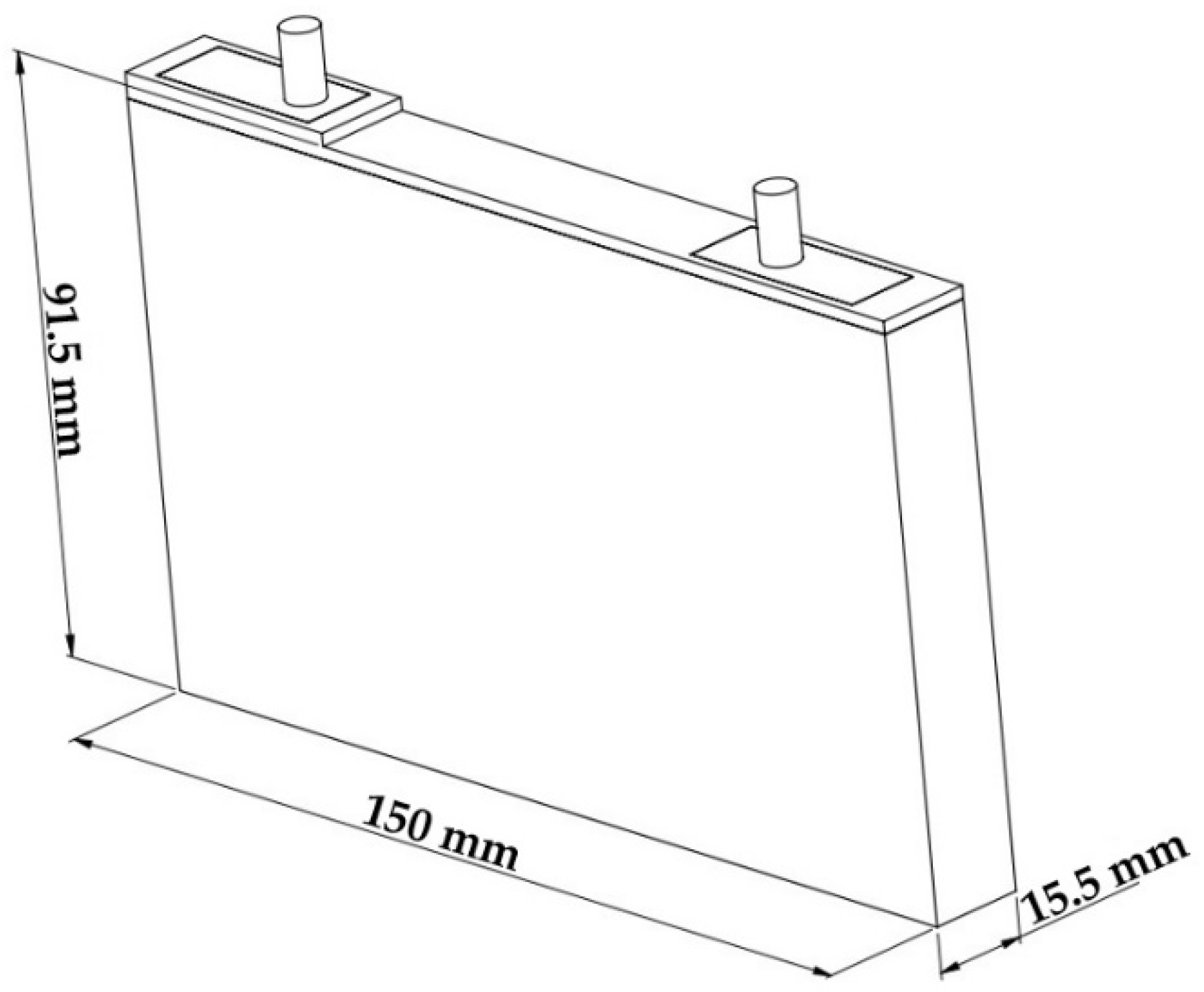
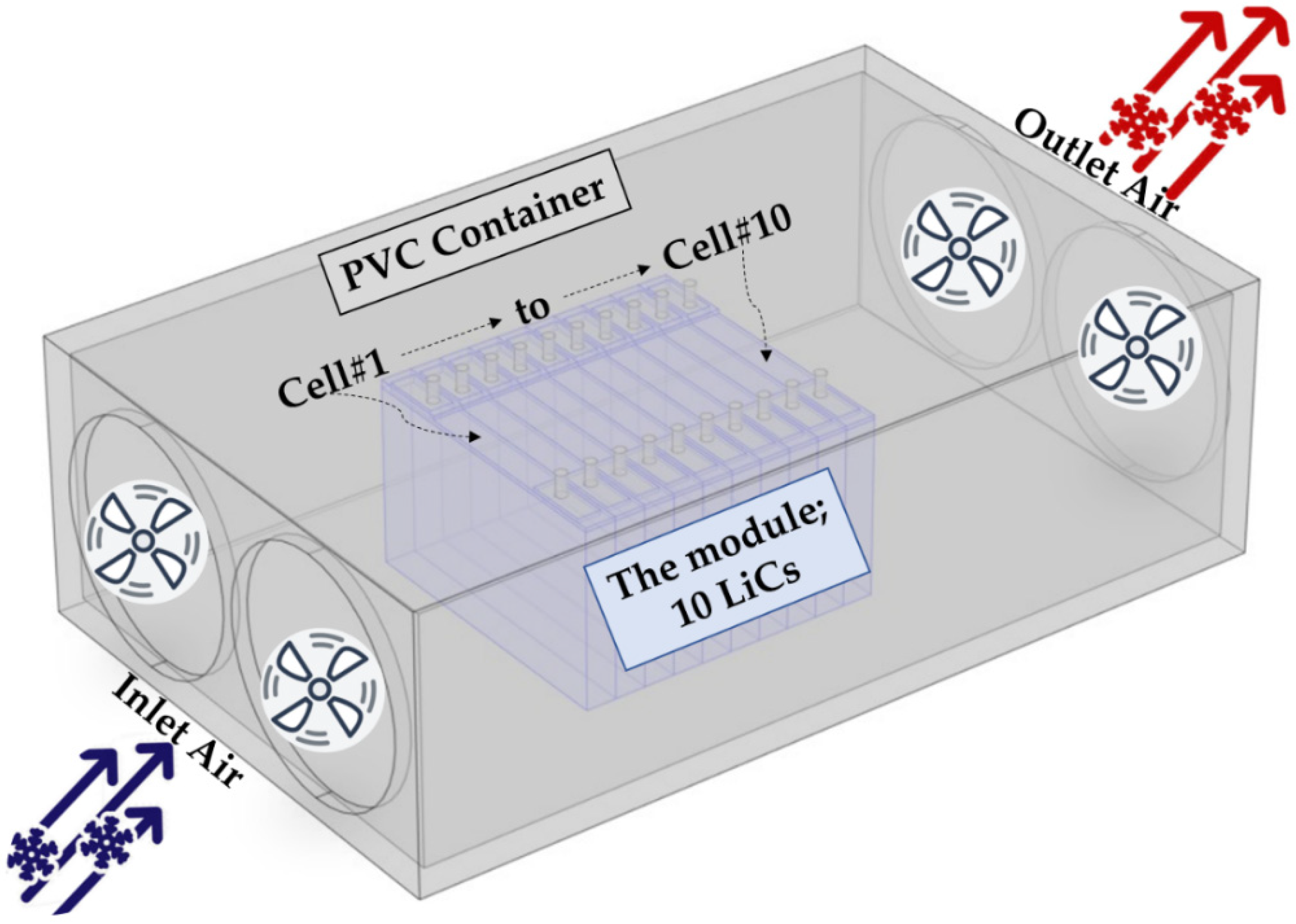





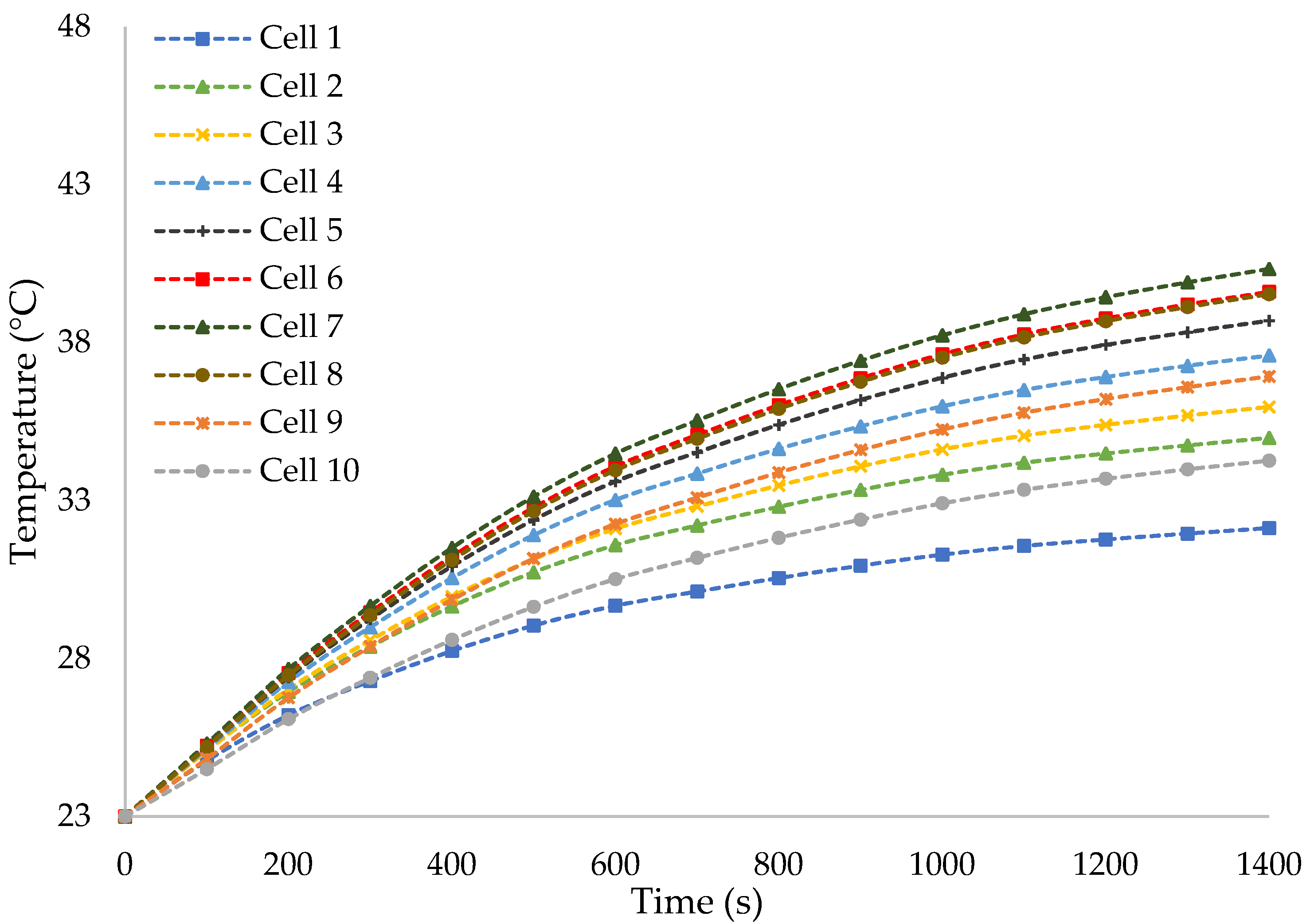

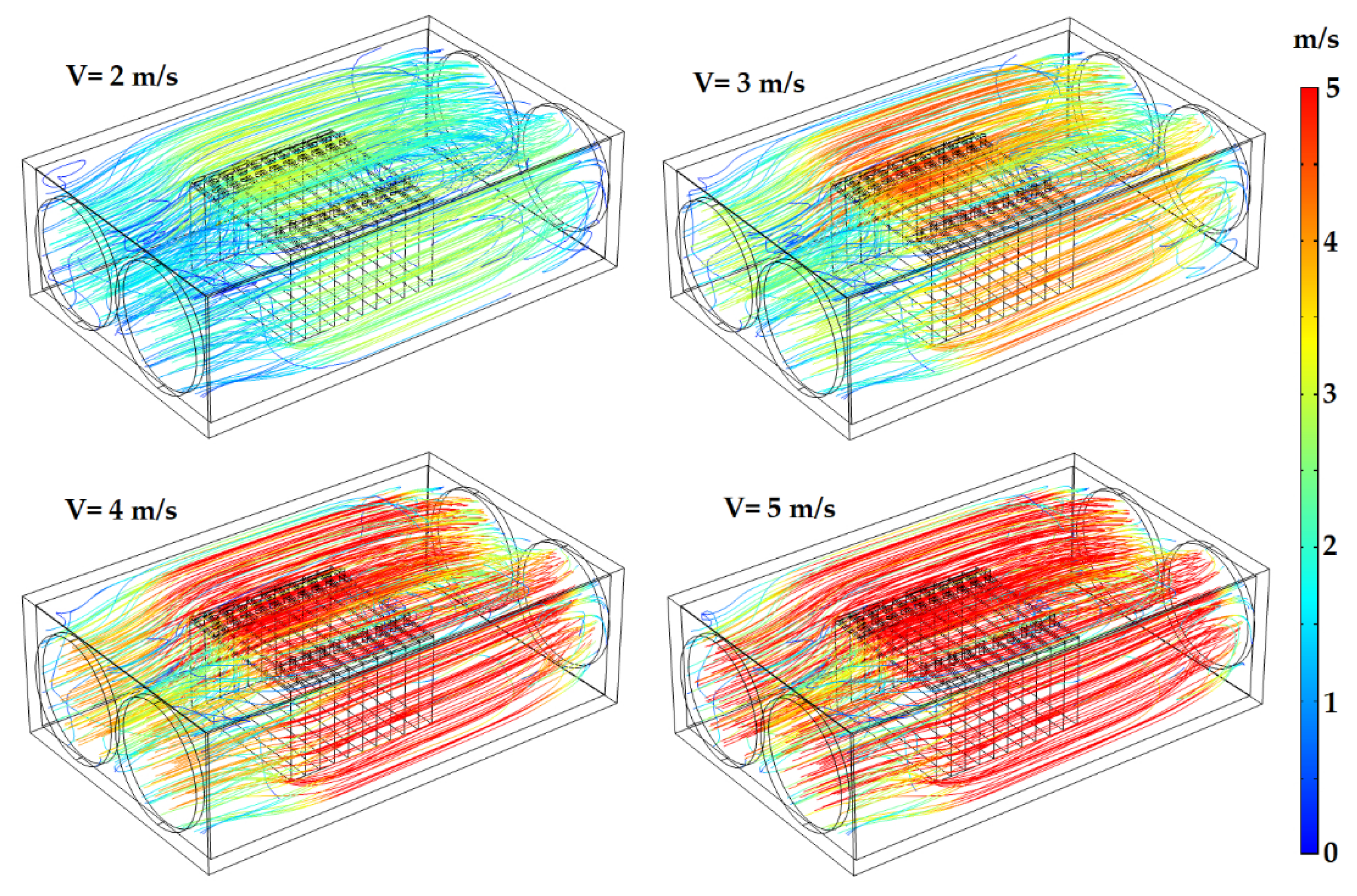
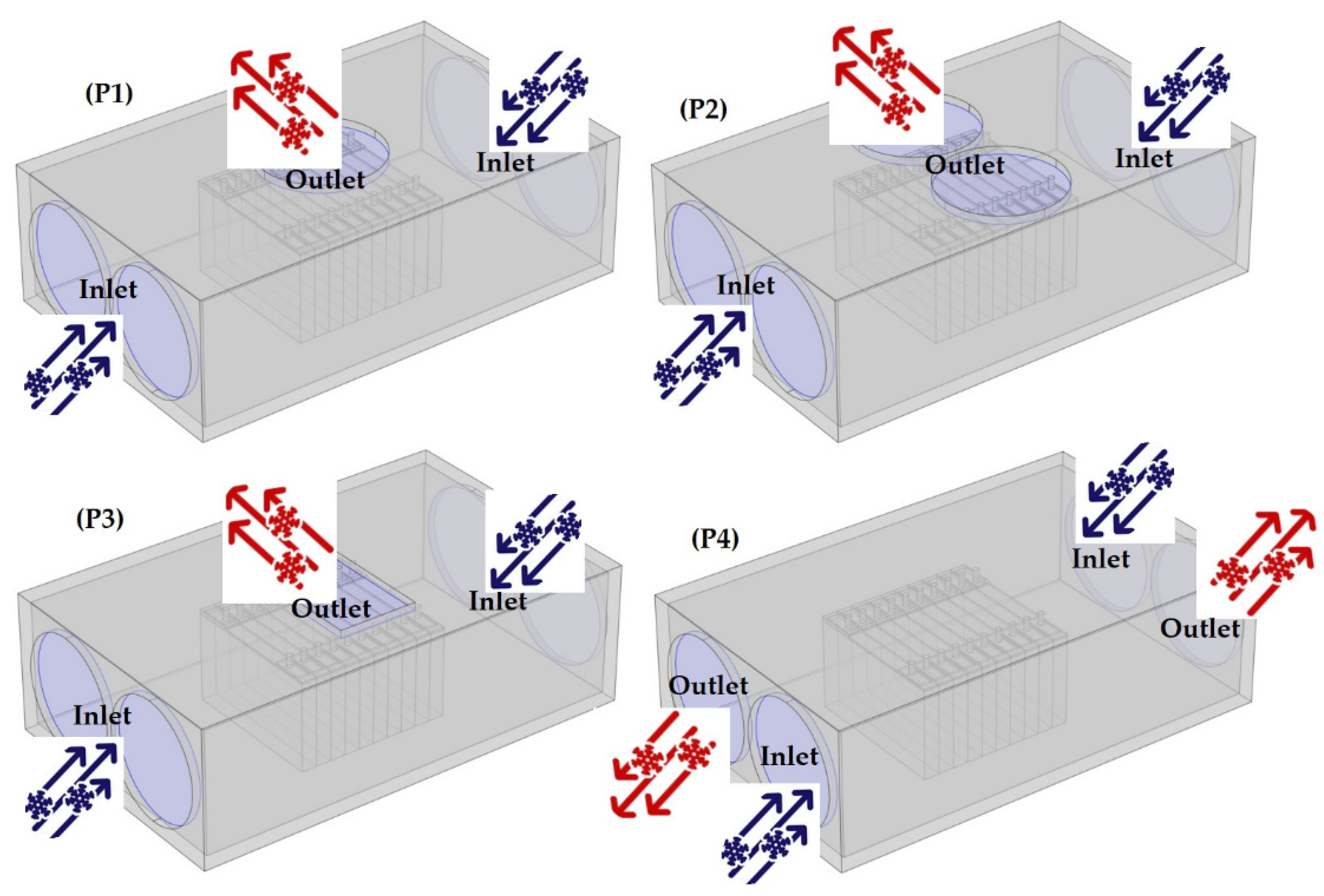
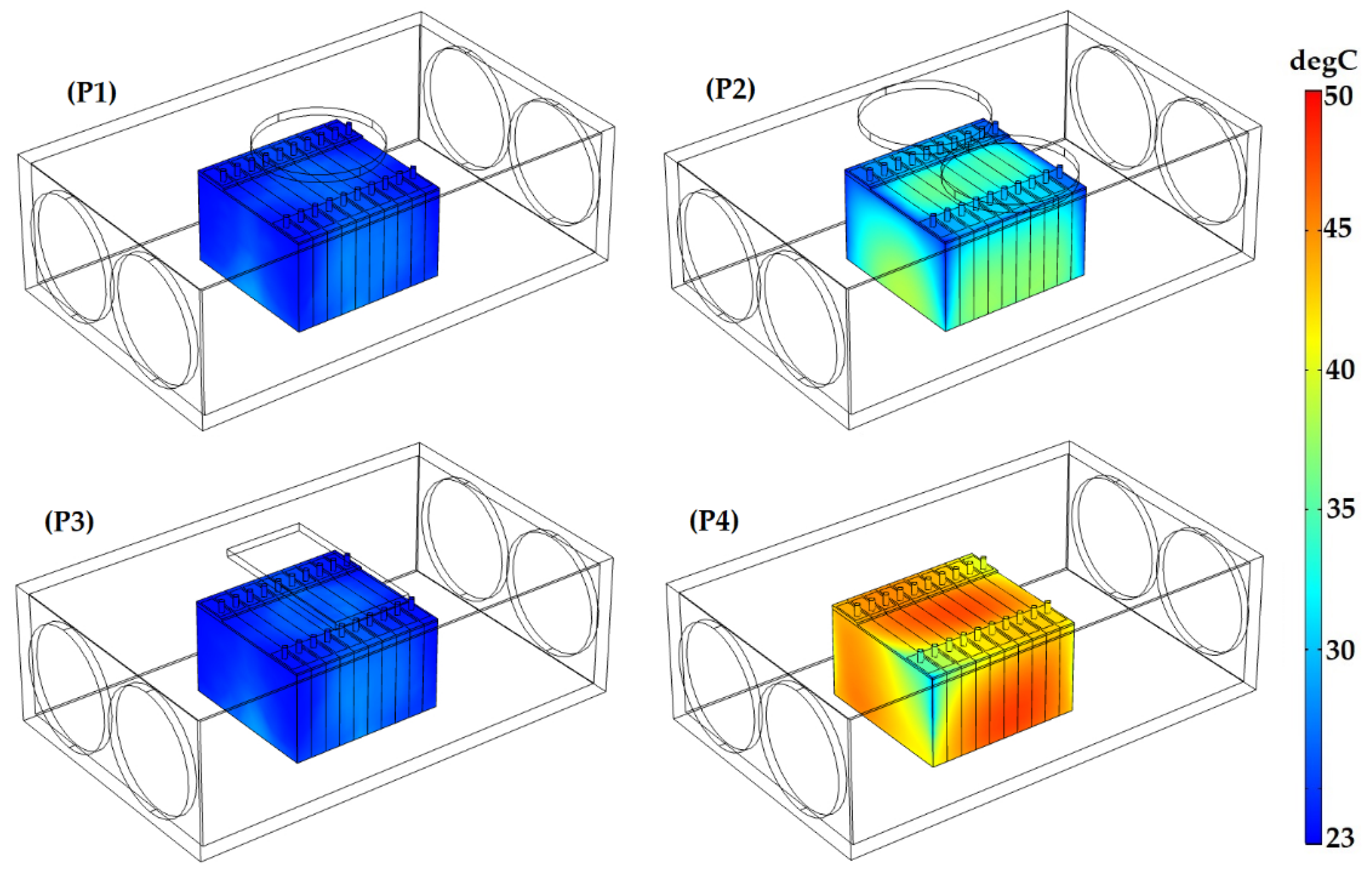

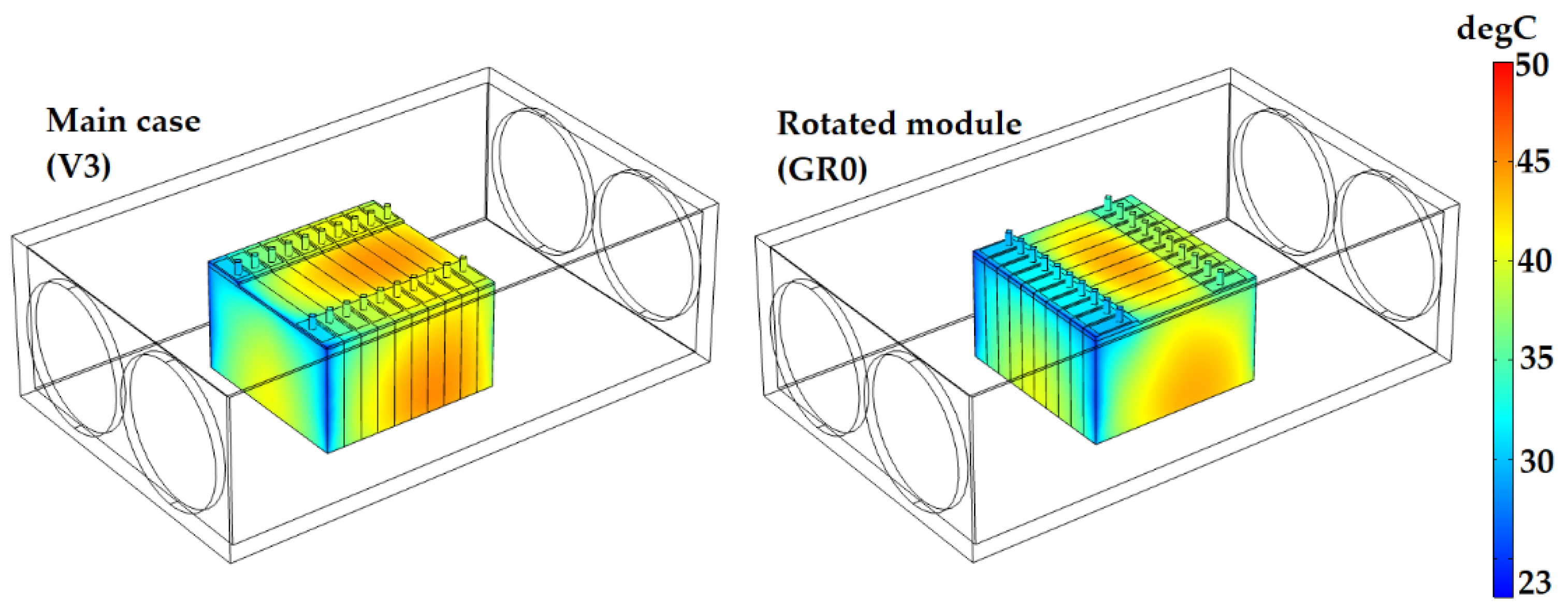
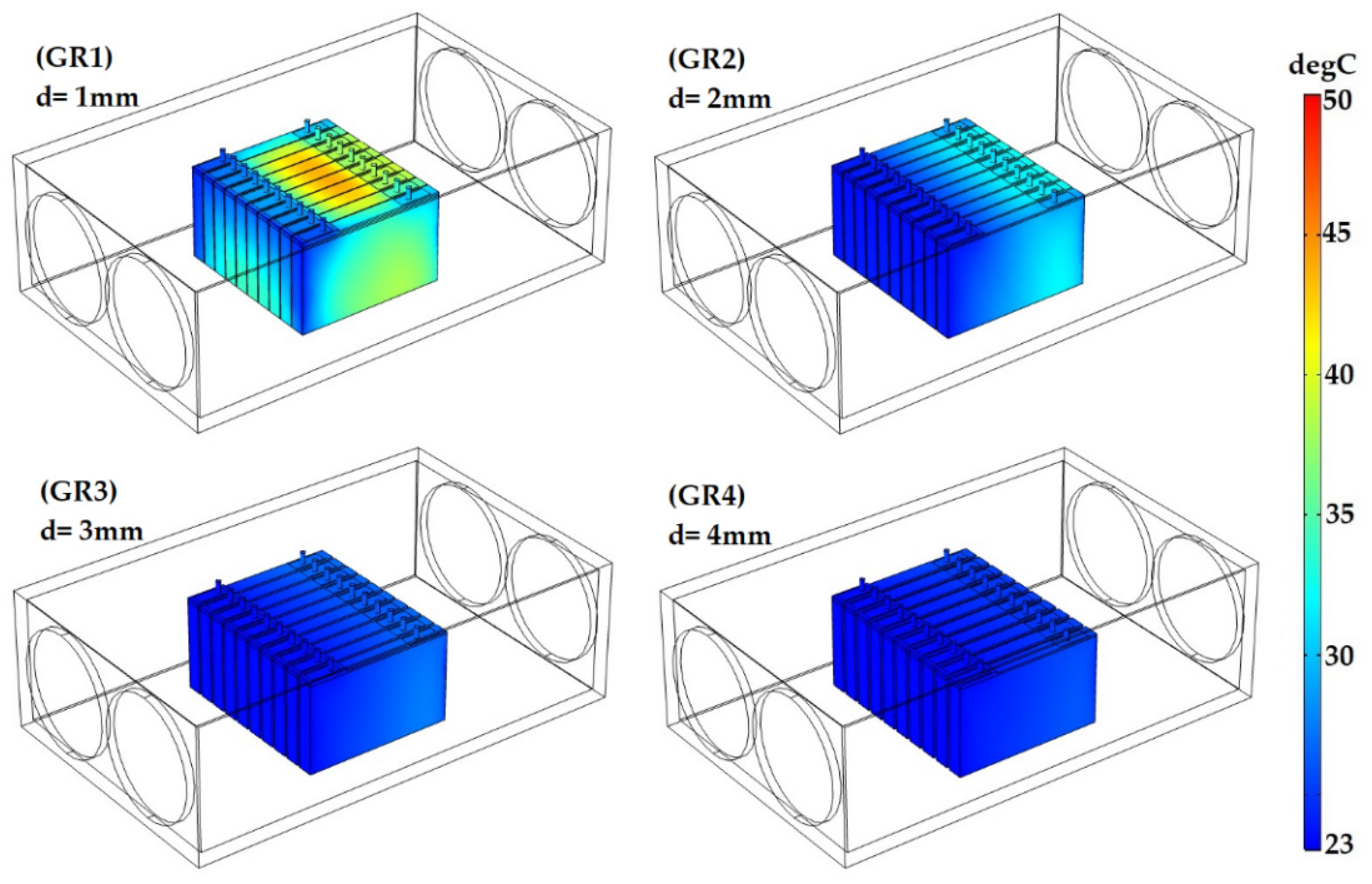


| Parameters | Value | Unit |
|---|---|---|
| Capacitance | 2300 | F |
| Minimum Voltage | 2.2 | V |
| Maximum Voltage | 3.8 | V |
| Weight | 0.35 | kg |
| Working Temperature | −30 to +70 | °C |
| Dimensions | Figure 1 | mm |
| Domains | Density kg/m3 | Thermal Conductivity W/(m.K) | Specific Heat J/(kg·K) |
|---|---|---|---|
| Electrode | 1627 | λy = λz = 5; λx = 0.36 | 1271 |
| Negative tab | 8960 | 400 | 385 |
| Positive tab | 2700 | 238 | 900 |
| Section | Condition | Value |
|---|---|---|
| LiC module domain | Initial temperature | 23 °C |
| LiC cell domain | Heat generation (per cell) | 76,477 W/m3 |
| PVC container | Initial temperature | 23 °C |
| Air (coolant) | Inlet temperature | 23 °C |
| Air (coolant) | Inlet flow rate | 3 m/s |
| Air (coolant) | Outlet pressure | To ambient |
| Air (coolant) | Wall | Non-slip |
| Case Study | Tmax (°C) | ΔTmax (°C) | Related Figure |
|---|---|---|---|
| Main case (V3) | 47.1 | 23.3 | Figure 9 |
| V2 | 49.2 | 24.7 | Figure 9 |
| V4 | 45.9 | 22.5 | Figure 9 |
| V5 | 44.8 | 21.5 | Figure 9 |
| P1 | 34.6 | 14.6 | Figure 12 |
| P2 | 41.8 | 18.5 | Figure 12 |
| P3 | 34.6 | 14.6 | Figure 12 |
| P4 | 49.6 | 24.4 | Figure 12 |
| G1 | 49.3 | 26.1 | Figure 13 |
| G2 | 49.1 | 25.9 | Figure 13 |
| G3 | 48.3 | 25.1 | Figure 13 |
| G4 | 47.1 | 23.8 | Figure 13 |
| GR0 | 46.3 | 22.6 | Figure 14 |
| GR1 | 46.2 | 23.1 | Figure 15 |
| GR2 | 34.4 | 14.4 | Figure 15 |
| GR3 | 27.5 | 4.5 | Figure 15 |
| GR4 | 26.1 | 3.1 | Figure 15 |
| U12 | 47.1 | 10.9 | Figure 17 |
| UR12 | 38.1 | 15.1 | Figure 17 |
| UR23 | 28.5 | 5.5 | Figure 17 |
Publisher’s Note: MDPI stays neutral with regard to jurisdictional claims in published maps and institutional affiliations. |
© 2021 by the authors. Licensee MDPI, Basel, Switzerland. This article is an open access article distributed under the terms and conditions of the Creative Commons Attribution (CC BY) license (https://creativecommons.org/licenses/by/4.0/).
Share and Cite
Karimi, D.; Behi, H.; Akbarzadeh, M.; Van Mierlo, J.; Berecibar, M. A Novel Air-Cooled Thermal Management Approach towards High-Power Lithium-Ion Capacitor Module for Electric Vehicles. Energies 2021, 14, 7150. https://doi.org/10.3390/en14217150
Karimi D, Behi H, Akbarzadeh M, Van Mierlo J, Berecibar M. A Novel Air-Cooled Thermal Management Approach towards High-Power Lithium-Ion Capacitor Module for Electric Vehicles. Energies. 2021; 14(21):7150. https://doi.org/10.3390/en14217150
Chicago/Turabian StyleKarimi, Danial, Hamidreza Behi, Mohsen Akbarzadeh, Joeri Van Mierlo, and Maitane Berecibar. 2021. "A Novel Air-Cooled Thermal Management Approach towards High-Power Lithium-Ion Capacitor Module for Electric Vehicles" Energies 14, no. 21: 7150. https://doi.org/10.3390/en14217150
APA StyleKarimi, D., Behi, H., Akbarzadeh, M., Van Mierlo, J., & Berecibar, M. (2021). A Novel Air-Cooled Thermal Management Approach towards High-Power Lithium-Ion Capacitor Module for Electric Vehicles. Energies, 14(21), 7150. https://doi.org/10.3390/en14217150










